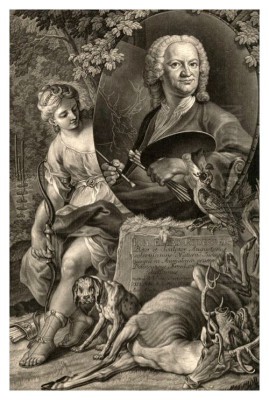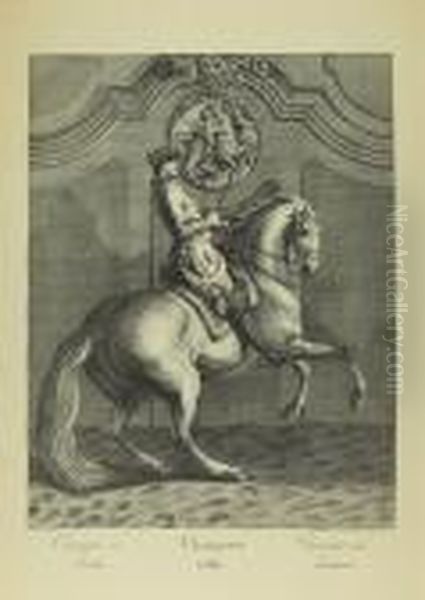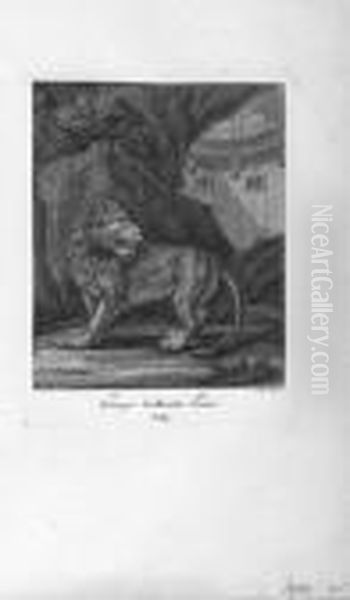
Johann Elias Ridinger stands as one of the most significant and prolific German artists of the 18th century, renowned primarily for his masterful depictions of animals, particularly horses and wildlife, as well as dynamic hunting scenes. Active during the late Baroque and Rococo periods, Ridinger excelled as a painter, engraver, etcher, and publisher. His work is characterized by meticulous observation, anatomical accuracy, and a lively naturalism that captured the spirit and movement of his subjects. Born in Ulm on February 16, 1698, and passing away in Augsburg on April 10, 1767, Ridinger left behind a vast oeuvre that continues to be admired and studied for its artistic merit and historical insight into the culture of his time.
Early Life and Artistic Formation in Ulm
Johann Elias Ridinger was born into a family environment that likely nurtured his artistic inclinations. His birthplace was the imperial city of Ulm, located in Swabia, now part of Bavaria, Germany. While some accounts differ, reliable sources indicate his father was a scribe or clerk who also possessed artistic skill, crafting small models of horses and other animals in his leisure time. Witnessing his father's craft may well have ignited the young Ridinger's fascination with animal forms and representation.
His formal artistic training began in Ulm. He initially studied under the painter Christoph Resch (c. 1660-1716). Following this foundational instruction, he apprenticed with the painter Johann Falck (or Falch) (1687-1727). Falck specialized in animal and landscape painting and emphasized the importance of studying nature directly. This mentorship proved crucial, instilling in Ridinger a commitment to careful observation and realistic portrayal that would become hallmarks of his mature style. Ulm, a significant city with artistic traditions, provided the initial environment for Ridinger to develop his talents.
Journey and Development: Regensburg and Augsburg
Seeking broader experience and patronage, Ridinger's journey took him beyond Ulm. Around 1717, he moved to Augsburg, a major artistic and publishing center in Southern Germany. He likely continued his studies there, possibly reconnecting with Johann Falck, who became not just a teacher but also a close friend and mentor according to some biographical accounts. Augsburg offered a vibrant artistic community and greater opportunities than Ulm.

A significant chapter in his development occurred around 1720 when Ridinger spent approximately three years in Regensburg. He entered the service of Count Wolff Freiherr von Metternich (likely Wolf von Metternich zur Gracht, a prominent figure). While some sources mention him working as a hound trainer, his primary role involved observing and documenting the Count's equestrian activities and hunting expeditions. This period was invaluable, providing him with firsthand, intensive exposure to horses in motion, the anatomy and behavior of hunting dogs, and the dramatic spectacles of the aristocratic hunt. These experiences deeply informed his later work, lending authenticity and dynamism to his depictions.
After his formative time in Regensburg, Ridinger returned to Augsburg around 1722. He sought further refinement of his skills, particularly in the graphic arts. He began studying engraving and etching under Georg Philipp Rugendas the Elder (1666-1742). Rugendas was a highly respected painter and engraver, particularly known for his battle scenes and depictions of horses. Studying with Rugendas undoubtedly honed Ridinger's technical proficiency in printmaking, a medium in which he would achieve immense success.
The Augsburg Years: Publisher and Academician
Augsburg became Ridinger's permanent home and the center of his prolific career. Recognizing the potential market for his specialized art, he took the entrepreneurial step of founding his own art publishing house (Kunstverlag) in 1723. This venture allowed him to maintain artistic control over his work and disseminate his prints widely. He designed, engraved, and published numerous series of prints, which quickly gained popularity among the nobility, sportsmen, and art collectors across Germany and beyond.
His publishing house became a family enterprise. Ridinger married Veronica Grimm in 1723, and they had children who would follow in his artistic footsteps. His sons, Martin Elias Ridinger (1730-1780) and Johann Jakob Ridinger (1735-1784), were trained by their father and eventually took over the publishing business after his death, ensuring the continued availability of his popular prints and adding their own contributions.
Ridinger's reputation grew steadily. His skill in capturing the essence of animals, combined with his technical mastery of engraving and etching, made his work highly sought after. His success was not limited to printmaking; he also worked as a painter, though fewer paintings survive compared to his vast graphic output. His prominence in Augsburg's artistic life was formally recognized in 1759 when he was appointed director of the Augsburg City Academy of Art (Städtische Kunstakademie), a prestigious position reflecting the high esteem in which he was held by his peers and the city authorities. He held this post until his death in 1767.
Artistic Style and Techniques

Johann Elias Ridinger's art bridges the late Baroque and the emerging Rococo styles, incorporating elements of both. His fundamental approach was rooted in the Baroque tradition's emphasis on naturalism and detailed observation, likely reinforced by his training with Johann Falck and his time studying animals from life in Regensburg. This is evident in the remarkable anatomical accuracy of his animals. He possessed a deep understanding of animal musculature, skeletal structure, and movement, particularly evident in his depictions of horses, deer, and dogs.
However, Ridinger's compositions often display a Rococo sensibility in their dynamism, decorative flourishes, and sometimes playful or elegant arrangements. While grounded in reality, his scenes are carefully composed for aesthetic effect. The landscapes serving as backdrops, often featuring gnarled trees and atmospheric skies, enhance the mood and provide context for the animal subjects. He masterfully used light and shadow (chiaroscuro) to model forms and create depth, particularly in his etchings and mezzotints.
Ridinger was exceptionally skilled in various printmaking techniques, primarily copperplate engraving and etching. Engraving allowed for precise, clean lines, ideal for detailed anatomical studies. Etching offered greater freedom and spontaneity, enabling him to capture the texture of fur and foliage and create more atmospheric effects. He sometimes combined techniques and also produced works in mezzotint, a tonal method well-suited for rich, dark backgrounds and subtle gradations. Many of his prints were later hand-colored, either in his workshop or by purchasers, adding to their decorative appeal.
Major Themes and Representative Works
Ridinger's oeuvre is dominated by animal subjects, explored through various themes. Hunting scenes were a major focus, catering to the interests of his aristocratic patrons. These prints depict various stages of the hunt, from the pursuit to the capture, featuring stags, wild boars, foxes, and hounds in dynamic action. His time in Regensburg provided ample material for these popular compositions.
Horses were another central theme. Ridinger produced extensive series depicting different breeds, equestrian exercises, and scenes from the riding school ('Reitschule'). His understanding of equine anatomy and movement was unparalleled among German artists of his time, rivaling specialists elsewhere in Europe. These prints served not only as art but also as references for horsemen and breeders.
Beyond hunting and horses, Ridinger created numerous series dedicated to wildlife. His Thier-reich (Animal Kingdom) is a significant work, comprising numerous plates illustrating a wide variety of animals, both domestic and exotic, often shown in characteristic poses and environments. These works demonstrate his broad zoological interest and observational skills. A notable example is his series of etchings depicting Clara, an Indian rhinoceros that toured Europe and visited Augsburg in 1748. Ridinger's depictions were among the first accurate European representations of the species, based on direct observation.
He also explored allegorical and didactic themes using animals. His series of animal fables, such as Instructive Fables from the Animal Kingdom (first published 1744), used animal interactions to convey moral lessons or social commentary. One such print, sometimes titled Malice Finally Revealed by Flattery, uses domestic pets in a wealthy interior to explore themes of deceit and loyalty, showcasing his ability to imbue animals with character.
Specific well-known works and series include:
Le Nouveau Manège (The New Riding School): A comprehensive series illustrating classical dressage and horsemanship.
Betrachtung der wilden Thiere (Observation of Wild Animals): A series showcasing various game animals in natural settings, noted for its accuracy. Includes the famous Stag Looking Left.
Abbildung der Jagdbaren Thiere mit derselben angefügten Fährten und Spuren (Depiction of Huntable Animals with their Added Tracks and Trails): Combined artistic portrayal with practical information for hunters.
Entwurf einiger Thiere (Sketches of Some Animals): Often featuring detailed studies of animal heads or forms.
The Paradise Series: Depicting peaceful gatherings of various animals, showcasing harmony in nature.
Prints of Clara the Rhinoceros (1748): Six etchings providing detailed and surprisingly gentle views of the famous animal.
Jäger und Falkoniers mit ihren Verrichtungen (Hunters and Falconers with their Activities): Documenting various aspects of hunting and falconry.
These series, often comprising dozens of individual prints, cemented Ridinger's reputation as the preeminent German animal artist of his era.
The World of Ridinger: Contemporaries and Connections
Johann Elias Ridinger operated within a vibrant artistic landscape, both locally in Augsburg and within the broader European context. His teachers, Christoph Resch, Johann Falck, and Georg Philipp Rugendas, were significant figures who shaped his early development. Rugendas, in particular, connected him to a strong Augsburg tradition of printmaking and dynamic composition.
Augsburg itself was a hub for artists during the 18th century, especially known for its Catholic frescoes and print publishing. Ridinger would have been aware of, and likely interacted with, prominent Augsburg contemporaries. These included painters like Johann Georg Bergmüller (1688-1762), a leading fresco painter and director of the Academy before Ridinger; Matthäus Günther (1705-1788), another major South German Rococo frescoist; and Gottfried Bernhard Göz (1708-1774), known for his paintings and engravings, often with religious or allegorical themes. While their primary subjects differed from Ridinger's specialization, they formed part of the city's artistic milieu. Johann Evangelist Holzer (1709-1740), a highly talented painter and draftsman whose career was cut short, was another notable Augsburg contemporary.
Looking beyond Augsburg, Ridinger's work can be situated within the broader European tradition of animal painting and printmaking. In France, artists like Jean-Baptiste Oudry (1686-1755) and François Desportes (1661-1743) were renowned for their depictions of animals, hunting scenes, and still lifes, often for royal patrons. While direct influence is difficult to trace, Ridinger's work shares thematic concerns with these French masters, though his style often exhibits a distinctly German character, perhaps more focused on precise detail than the decorative elegance of the French Rococo.
In Prussia, Antoine Pesne (1683-1757), the French-born court painter to Frederick the Great, also occasionally depicted animals within his portraits and genre scenes. Although operating in different circles, their careers overlapped chronologically.
Later in the century, the English painter George Stubbs (1724-1806) would bring an unprecedented level of scientific rigor to equine portraiture, conducting detailed anatomical studies. While Stubbs's approach was perhaps more overtly scientific, Ridinger's earlier work already demonstrated a profound commitment to anatomical accuracy, placing him as a key figure in the development of realistic animal art in the 18th century.
Ridinger's patrons, like Count von Metternich in Regensburg, were crucial for his career. The aristocracy's passion for hunting and horsemanship created a strong market for his specialized prints. His publishing venture allowed him to reach a wider audience beyond direct patronage, including lesser nobility, wealthy burghers, and fellow artists.
Anecdotes and Notable Events
Several anecdotes and events illuminate Ridinger's life and work. His father's hobby of making animal models is often cited as an early formative influence, suggesting an innate family interest in the animal world that Johann Elias would elevate to high art.
The encounter with Clara the Indian rhinoceros in Augsburg in 1748 was a significant event. The arrival of such an exotic creature caused a sensation. Ridinger seized the opportunity to study the animal closely, resulting in his series of six etchings. These prints are notable not only for their accuracy, which corrected many fantastical European notions about rhinoceroses (partly derived from Dürer's famous but inaccurate woodcut), but also for their sympathetic portrayal of the animal, depicting it calmly eating and resting, rather than as a fearsome monster.
His time spent in Regensburg, meticulously observing hunts and stable life at Count von Metternich's estate, was more than just employment; it was an immersive research period. This dedication to firsthand observation underpins the convincing realism of his subsequent work. He wasn't just drawing animals; he was studying their behavior, their interactions, and their place within the human activities of riding and hunting.
The establishment of his own publishing house in 1723 was a bold move for a young artist. It demonstrated business acumen alongside artistic talent. This control over production and distribution was key to his widespread influence and financial success, allowing his work to circulate far more broadly than if he had relied solely on commissions or other publishers.
His series of animal fables also reveals another dimension of his work – the use of animals for moral or satirical commentary. These prints show his engagement with contemporary intellectual currents and the tradition of the illustrated fable, which had been popular since the Renaissance. They demonstrate his versatility beyond straightforward natural history depiction.
Legacy and Influence
Johann Elias Ridinger's legacy is substantial and multifaceted. He is widely regarded as the most important German animal artist of the 18th century and one of the leading European printmakers specializing in animal and hunting subjects. His influence extended through several channels.
Firstly, his prints were immensely popular during his lifetime and remained so for decades after his death. His sons, Martin Elias and Johann Jakob, continued the publishing house, reissuing his plates and ensuring his designs remained in circulation well into the late 18th and early 19th centuries. This sustained availability solidified his impact.
Secondly, Ridinger's designs had a significant influence on the decorative arts. His detailed and dynamic depictions of animals and hunting scenes were frequently copied or adapted for decorating porcelain (e.g., Meissen, Nymphenburg), faience, tapestries, glassware, and even furniture. His prints served as a rich sourcebook for craftsmen across various media, disseminating his style and motifs widely throughout Germany and neighboring countries.
Thirdly, his work served an educational purpose. His accurate anatomical renderings and depictions of different breeds and species were valued for their informational content. His prints were used as drawing models and references for natural history study. The fact that some series were reissued for educational purposes even into the 19th and early 20th centuries attests to their perceived accuracy and utility.
Fourthly, Ridinger influenced subsequent generations of artists specializing in animal subjects, particularly in Germany. While perhaps overshadowed internationally by figures like Oudry or Stubbs, his work set a high standard for realism and technical skill within the German-speaking world. His dedication to observation and anatomical understanding paved the way for later developments in animal art. Even modern designers have found inspiration in his work, as seen in references to his hunting motifs.
Today, Ridinger's prints and drawings are held in major museum collections worldwide, including the Metropolitan Museum of Art in New York, the National Gallery of Art in Washington D.C., the British Museum in London, the Rijksmuseum in Amsterdam, and numerous German institutions like the Staatliche Graphische Sammlung in Munich. His work continues to be studied by art historians, print specialists, and those interested in the history of hunting, equestrianism, and natural history illustration.
Conclusion
Johann Elias Ridinger was far more than just a painter of animals. He was a master draftsman, a highly skilled engraver and etcher, a successful publisher, and an influential teacher. His deep connection with the natural world, combined with his technical virtuosity and entrepreneurial spirit, allowed him to create a vast and enduring body of work. He captured the vitality of animals and the drama of the hunt with unparalleled skill in 18th-century Germany. His meticulous attention to detail, anatomical accuracy, and ability to convey movement and character set his work apart. Through his prints, Ridinger not only catered to the tastes of his time but also created lasting images that influenced decorative arts, provided educational resources, and continue to fascinate viewers today. He remains a pivotal figure in the history of animal art and German printmaking.